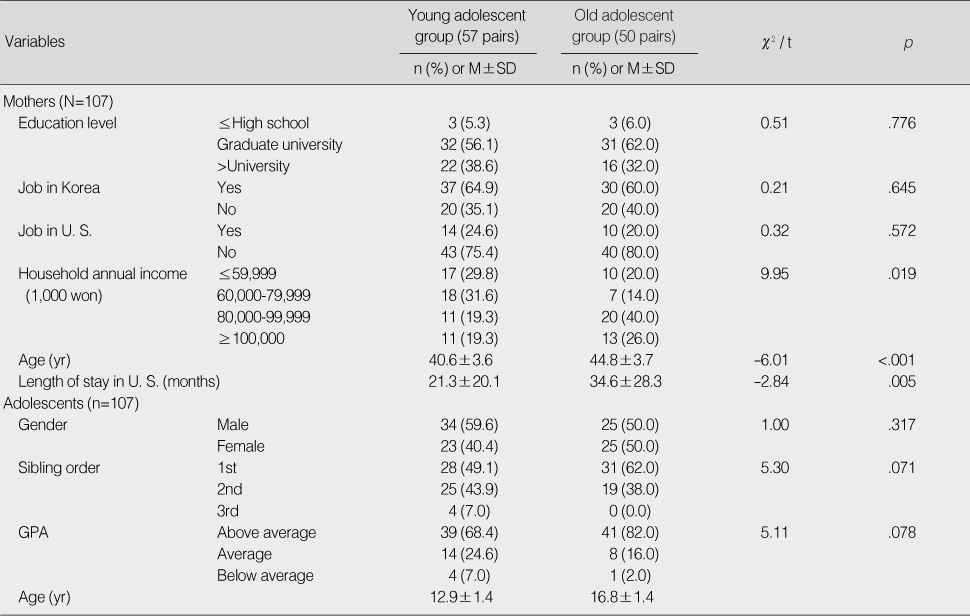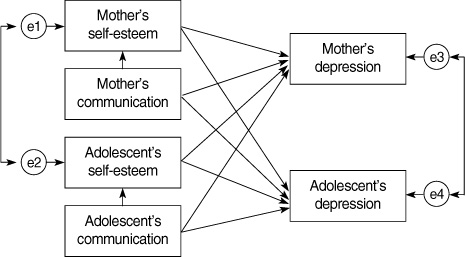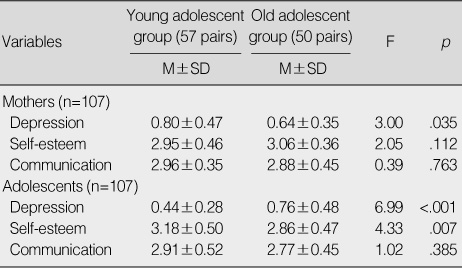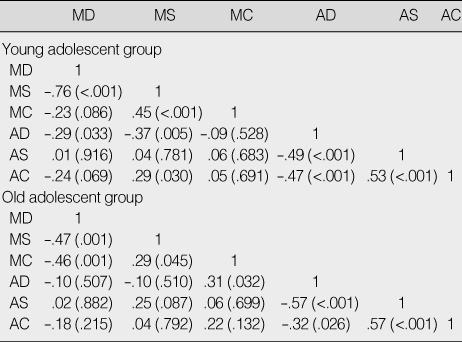Articles
- Page Path
- HOME > J Korean Acad Nurs > Volume 40(5); 2010 > Article
-
Original Article
- The Actor Effect and the Partner Effect of Self-esteem and Mother-Adolescent Communication on Depression in Mothers and Adolescents in Kirogi Families according to Adolescent' Development Stage
- Eun Kyung Yun, Sung Hee Shin
-
Journal of Korean Academy of Nursing 2010;40(5):620-630.
DOI: https://doi.org/10.4040/jkan.2010.40.5.620
Published online: October 31, 2010
Full-time Lecturer, College of Nursing Science East-West Nursing Research Institute, Kyung Hee University, Seoul, Korea.
- Address reprint requests to: Shin, Sung Hee. College of Nursing Science, Kyung Hee University, 1 Hoegi-dong, Dongdaemun-gu, Seoul 130-701, Korea. Tel: 82-2-961-0917, Fax: 82-2-961-9398, sunghshin@khu.ac.kr
Copyright © 2010 Korean Society of Nursing Science
Abstract
-
Purpose
- This study was conducted to compare the level of depression, self-esteem and mother-adolescent (M-A) communication perceived by both mothers and adolescents between the early adolescent (E-A) group and the late adolescent (L-A) group; and to examine the actor effect and the partner effect of self-esteem and M-A communication on depression in mothers and adolescents.
-
Methods
- Participants were 107 Kirogi families who resided in the Midwest region of the U. S. Data were collected from September, 2008 to March, 2009 using the scales of Center for Epidemiologic Studies Depression (CES-D), Self-esteem and Parent-Adolescent Communication Inventory.
-
Results
- Mothers in E-A group reported higher scores on depression than mothers in L-A group. Adolescents in L-A group reported higher scores on depression and lower scores on self-esteem than adolescents in E-A group. In the E-A group, mothers' self-esteem had big actor effect on mothers' depression and partner effect on adolescents' depression. In the L-A group, self-esteem of mothers and adolescents had actor effect on their depression respectively without partner effect. M-A communication of mothers influences mothers' depression negatively and adolescents' depression positively. In both group, M-A communication influences their depression with mediating effect of self-esteem.
-
Conclusion
- To promote Kirogi families' mental health, programs for mothers and adolescents should be developed differently according to adolescents' development stage.
- 1. Barens H, Olson DH. Parent-adolescent communication, family inventories. 1982;Minneapolis, MN, University of Minnesota Press.
- 2. Choi IJ. The effects of parent-adolescent communication on adolescent's self-differentiation, depression and anxiety. Korean Journal of Clinical Psychology. 2007;26:611–628.Article
- 3. Choi SY, Lee JM. The effects of maternal depression and adolescent's self-esteem on the adolescent's social anxiety. Korean Journal of Human Ecology. 2008;17:835–845.Article
- 4. Choi YS. The phenomenon of "geese-families": Marital separation between geese-fathers and geese-mothers. Family and Culture. 2006;18(2):37–65.
- 5. Chung MJ, Yuh J. Effects of individual and social factors on children's affective problems and self-worth. Korean Journal of Child Studies. 2009;30(3):71–83.
- 6. Faul F, Erdfelder E, Lang A, Buchner A. G Power 3: A flexible statistical power analysis program for the social, behavioral, and biomedical sciences. Behavior Research Methods. 2007;39:175–191.ArticlePubMedPDF
- 7. Ha M. 'Kirogi' families weigh risks and rewards. The Korea Times. 2007;11 01 Retrieved February 10, 2010. from http://news.naver.com/main/read.nhn?mode=LSD&mid=sec&sid1=001&oid=040&aid=0000046457.
- 8. Hammen C, Altman T, Brennan P. Interpersonal impairment and the prediction of depressive symptoms in adolescent children of depressed and nondepressed mothers. Journal of the American Academy of Child and Adolescent Psychiatry. 2003;42:571–577.ArticlePubMed
- 9. Hong SH. The criteria for selecting appropriate fit indices in structural equation modeling and their rationales. Korean Journal of Clinical Psychology. 2000;19:161–177.
- 10. Jeon BJ. Self-esteem: A test of its measurability. Yonsei Nonchong. 1974;1:107–130.
- 11. Kenny D. Models of non-independence in dyadic research. Journal of Social and Personal Relationships. 1996;13:279–294.ArticlePDF
- 12. Kim JS, Shin KR. A study on depression, stress, and social support in adult women. Journal of Korean Academy of Nursing. 2004;34:352–361.ArticlePubMedPDF
- 13. Kim SM. A qualitative study on wild goose mothers' everyday life, family relationship and social networking. Journal of Korean Family Resource Management Association. 2009;13:41–59.
- 14. Kim YH, An SM. Family cohesion, family adaptability, parent-adolescent communication, family conflict, and adolescents' depression & delinquency. Korean Journal of Youth Studies. 2008;15(2):1–31.
- 15. Kim YH, Chang OJ. Issue of families that run separate household for a long time. Journal of Family Relations. 2004;9(2):1–23.
- 16. Kim YH, Choi MS, Lee JH. Actual state of Korean "Geese mother" in New Zealand. Journal of the Korean Home Economics Association. 2005;43(11):141–152.
- 17. A report of population and households. Korea National Statistical Office. 2008;Retrieved December 10, 2009. from http://kosis.kr/metadata/main.jsp?c_id=1962004.
- 18. Kwahk SH, Kim SO. Depression and anxiety related with married women's attachment security and self-esteem: Focused on the mothers of elementary school students. Journal of the Korean Home Economics Association. 2002;45(7):35–48.
- 19. Kwon SY. Causal relations among perceived depression, self-esteem, and social support of adolescents. Secondary Education Research. 2008;56(2):93–118.
- 20. Lee CH, Chung JS, Rhee M. The influence of patient-adolescent communication on adolescent's depression: Mediation effect of self-esteem and irrational belief. Korean Journal of Health Psychology. 2009;14:433–448.
- 21. Lee SY. Factors related to the depression of young Korean oversea students in U. S. Korean Journal of Youth Studies. 2009;16(5):99–120.
- 22. Min HY. Circumplex model and parent-adolescent communication. 1990;Seoul, Yonsei University. Unpublished master's thesis.
- 23. Min SJ. The relations of parents-children' self-esteem and the necessity of parent' education. 2003;Anyang, Anyang University. Unpublished master's thesis.
- 24. Education statistics. Ministry of Education, Science and Technology. 2008;Retrieved February 13, 2010. from http://www.mest.go.kr/ms_kor/inform/info_data/cooper/1256539_8477.jsp.
- 25. Montemayor R. The relationship between parent-adolescent conflict and the amount of time adolescents spend alone and with parents and peers. Child Development. 1982;53:1512–1519.Article
- 26. Mufson L. Interpersonal psychotherapy for depressed adolescents. 2004;2nd Ed. New York, NY, Guilford Press.
- 27. Park B. Factors associated with adolescents' suicidal ideation: Focus on self-esteem and depression as mediators. Korean Journal of Human Ecology. 2007;16:505–522.Article
- 28. Park HS. Study on the relationship between depression, health promoting behavior, self-esteem, and optimism in middle-aged women. Journal of Korean Academy of Psychiatric and Mental Health Nursing. 2002;11:352–362.
- 29. Radloff L. The CES-D scale: A self-report depression scale for research in the general population. Applied Psychological Measurement. 1977;385–401.
- 30. Rosenberg M. Society and the adolescent self-image. 1965;Princeton, NJ, Princeton University Press.
REFERENCES


Figure & Data
REFERENCES
Citations

-
Navigating motherhood across borders: An integrative review of role transformation and emotional challenges among Korean
kirogi
mothers
Boram Lee
Journal of Human Behavior in the Social Environment.2025; : 1. CrossRef - Testing of the factor structure of the Center for Epidemiologic Studies Depression Scale 10 in a sample of Korean “geese” mothers
Boram Lee
Health Care for Women International.2019; 40(5): 539. CrossRef - The Effects of Self-esteem and Family Stress on Depression of Middle-aged Couples: Analysis of Actor-Partner Interdependence Model
Yu Jeong Yang, Sung Hee Shin
Journal of Korean Academy of Psychiatric and Mental Health Nursing.2014; 23(2): 60. CrossRef - The mental health of Korean transnational mothers: A scoping review
Jaemin Kim, Branka Agic, Kwame McKenzie
International Journal of Social Psychiatry.2014; 60(8): 783. CrossRef


Figure 1
Figure 2
General Characteristics and Homogeneity between Young Adolescent Group and Old Adolescent Group
Differences in the Level of Variables between Young Adolescent Group and Old Adolescent Group
Mother's age, household annual income and length of stay in U.S. were controlled by MANCOVA.
Pearson Coefficient Correlations for Measured Variables in the Two Groups
MD=Mothers' Depression; MS=Mothers' Self-esteem; MC=Mothers' Communication; AD=Adolescents' Depression; AS=Adolescents' Self-esteem; AC=Adolescents' Communication.
Mother's age, household annual income and length of stay in U.S. were controlled by MANCOVA.
MD=Mothers' Depression; MS=Mothers' Self-esteem; MC=Mothers' Communication; AD=Adolescents' Depression; AS=Adolescents' Self-esteem; AC=Adolescents' Communication.
 KSNS
KSNS
 E-SUBMISSION
E-SUBMISSION



 Cite
Cite

